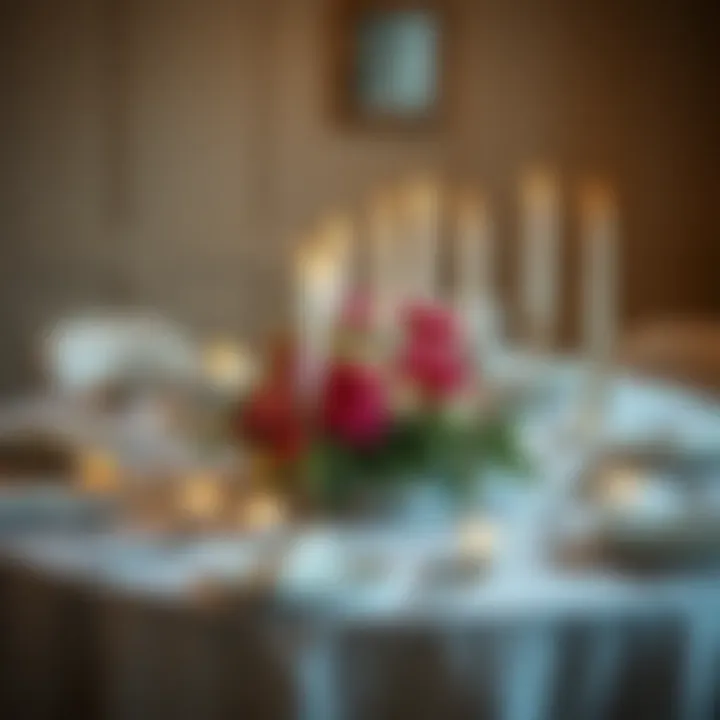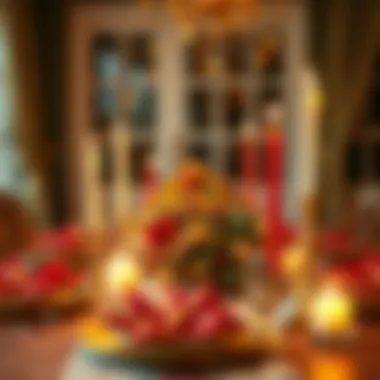Crafting an Elegant Candlelit Dinner Table


Intro
Setting the stage for a candlelit dinner requires more than just lighting a few candles. It’s an art that harmonizes aesthetics with functionality. An inviting table not only elevates the dining experience but also reflects your personality and creativity. Whether you're hosting a romantic dinner for two or a festive gathering with friends, the arrangement of the table speaks volumes about the occasion.
The quintessential elements of a candlelit table include thoughtful use of color, texture, and decor. Each aspect plays a crucial role in establishing the right mood. The goal is to create an atmosphere that encourages conversation and connection while enhancing the overall dining experience. This guide breaks down various aspects to consider to ensure your candlelit dinner table becomes a memorable centerpiece.
Choosing the Right Colors
Colors set the tone for any gathering. Soft hues like deep reds, muted greens, or elegant golds can create a sophisticated environment. When choosing colors, think not only about your tableware but also the overall decor of the dining area. Understanding color psychology can lead you to select options that resonate not just visually, but emotionally.
- Color Harmony: Combine complementary colors for an attractive palette. For instance, pairing navy blue with gold creates a rich look that is both modern and timeless.
- Seasonal Touches: Changing colors with the seasons can keep your decor fresh. Think warm oranges and browns for fall, pastel shades for spring.
Deciding on Materials
What your table is made of can make a significant impact. Think about the following materials:
- Tablecloths: Fabric options like linen give a relaxed feel, while satin offers a more formal touch.
- Dinnerware: Select pieces that reflect your style. Bone china can offer elegance, while stoneware gives a casual vibe.
- Candle Holders: Mixing materials, like glass and metal, can add layers of interest.
Engaging with Light
Lighting is at the heart of a candlelit dinner. Candles not only provide illumination but also contribute to the ambiance. Here are some ideas to consider:
- Positioning: Place candles at varying heights. Use candlesticks, votives, and tealights to create a dynamic look.
- Flickering Effect: Consider LED candles for a worry-free experience with the same effect. They can mimic the flickering glow without the mess.
Thoughtful Decor Elements
Adding personal touches to your table can enhance the experience:
- Floral Arrangements: Fresh flowers bring life to any table. Choose seasonal blooms to keep it natural and in harmony with both the occasion and the season.
- Personal Touches: Place name cards or little notes for guests to add a personal touch. This makes everyone feel valued and remembered.
Final Touches
Don't skip the small but significant details:
- Utensil Placement: The arrangement of forks, knives, and glasses should be methodical yet stylish. Consider using decorative chargers for a chic look.
- Ambient Sounds: Soft music can complement the dinner and enhance the atmosphere. Selecting the right playlist can be just as important as the menu.
"A well-set table is like an engaging story; it invites people in and makes them feel at home."
Prelims to Candlelit Dinner Tables
Setting a candlelit dinner table is not just about placing some candles on a nice tablecloth; it encompasses a blend of elements that together create an experience beyond mere dining. The atmosphere one manages to cultivate at the table can transform a mundane meal into a memory that lingers in the hearts of all present. As we venture further into this guide, it becomes clear that every detail matters—from the flicker of the candle to the choice of tableware.
The Significance of Atmosphere in Dining
Creating the right atmosphere is paramount when it comes to enjoying food with others. An inviting environment stimulates conversation, enhances flavor perception, and makes guests feel truly valued. This ambiance can be described as the unsung hero of dining experiences. Who hasn’t walked into a place where the lighting was just right, and the arrangement seemed to beckon one forward?
Apart from just achieving visual appeal, the ambiance also invokes feelings and memories, influencing how one perceives the meal. When candlelight dances across the table, it brings a warmth that stark fluorescent lights simply cannot emulate. A study conducted by the University of Sussex suggests that ambient lighting significantly increases meal enjoyment.
In forming a captivating atmosphere, one must also consider how scent and sound play roles in the overall experience. A subtle bouquet of flowers might contribute to a pleasant olfactory backdrop, while soft music can enhance the mood without overshadowing conversation. It's about crafting a sensory symphony that celebrates both the food and the moments shared around the table.
Purpose and Occasion
Each dinner table gathering holds its own significance—be it a cozy dinner for two, a festive family reunion, or a grand celebration of milestones. Understanding the purpose behind a candlelit dinner can help in fine-tuning the elements to be included in the table setting.
For romantic evenings, the table could be adorned with delicate fabrics, soft colors, and personal touches that reflect shared memories. Romantic dinners evoke intimacy, calling for arrangements that invite closeness, perhaps even including the couple's favorite dishes.


On the other hand, family gatherings would benefit from a lively and eclectic tableau that showcases delightful food and stories. Incorporating elements of nostalgia can make it all the more special, turning a simple meal into a cherished occasion. Thus, every event has its unique vibe, requiring careful consideration in the selection of decor and arrangement.
Summary
Setting a candlelit dinner table is an art that goes beyond aesthetics. It plays a crucial role in creating an atmosphere conducive to enjoyment and connection. Whether it’s for romance or family, understanding the significance and purpose behind each gathering allows one to curate a memorable dining experience.
In the next section, we will explore the key elements that make up a candlelit table setting, paving the way for a truly captivating experience that enchants all guests involved.
Key Elements of a Candlelit Table Setting
Creating the perfect atmosphere for a candlelit dinner is no small feat. It's like setting the stage for an unfolding drama where every element plays a part — from the type of candles to the textures of the napkins. The art of a candlelit table setting isn't just about lighting some flickering flames; it's about cultivating an inviting environment that enhances the dining experience. A well-arranged table speaks volumes about thoughtfulness and attention to detail.
Candle Selection
Types of Candles
When it comes to types of candles, the options are as varied as the stars in the sky. You might find pillar candles standing tall, tea lights adding a soft glow, or even votives tucked into charming holders. Pillar candles often serve as the centerpiece, offering a robust light that can chase away shadows, making them a popular choice for occasions that call for a sense of grandeur. On the flip side, tea lights can be scattered across the table, creating a starry effect that feels intimate. Each type has its character, influencing the mood differently. An interested candleburner might note that while scented options can enhance the atmosphere through aroma, they might also clash with food smells—a nuance that deserves consideration.
Sizes and Shapes
Sizes and shapes of candles can create visual interest along with functionality. Think about the interplay of tall taper candles with short tea lights, for instance; the variation in height draws the eye and can spiral upwards into a delightful display. Shorter candles make a table feel approachable, while taller versions can lend an air of elegance. However, one must be cautious of over-using large candles that could overshadow diners or make conversations difficult. A mix of shapes, too—perhaps combining round and square elements—can also add layers to the visual texture without overwhelming the overall aesthetic.
Fragrance Considerations
Speaking of flavors and odors, fragrance plays a pivotal role in any dining experience. When choosing scented candles, think outside the box. For instance, a candle with notes of fresh citrus can complement a seafood dish beautifully, introducing a refreshing aspect to the meal as it unfolds. Yet, the wrong scent—say, something musky or overpoweringly sweet—can easily lead to an awkward clash of aromas. A good rule of thumb is to steer clear of strongly perfumed candles for meals rich in flavor; they could compete rather than harmonize. This aspect requires delicate balancing act to ensure the experience is coherent and harmonious.
Table Linens
Choosing Fabric
Selecting table fabrics sets the groundwork for the entire dining experience. A soft linen invites guests to relax, while a crisp cotton can offer a more formal touch. It's a common practice to choose based on the occasion—for a romantic dinner, consider exquisite silk tablecloths that shimmer under candlelight. However, while silk may be fancy, it can also face its share of laundry woes. Rather than opting for a dainty fabric that shows every spill, you might consider blends that offer both luxury and functionality. The choice of texture can dramatically shift the feeling of the table, welcoming guests with open arms.
Color Theory
Color can often leverage powerful psychological responses. Choosing the right palette can evoke warmth, calm, or excitement. While bold reds might scream passion, muted earth tones can offer a grounding effect. It’s worth noting that coordinating colors with the theme of the meal or season can enhance the overall experience. For example, rich, autumnal hues are suitable for a harvest feast. However, striking the right mix isn’t just about aesthetics—consider the emotional weight colors carry. A well-prepared table ought to invite and soothe, rather than agitate or overwhelm.
Layering Techniques
Layering techniques can take a table from drab to fab quite effortlessly. Think of a tablecloth adorned with a delicate lace overlay or a bold runner that contrasts with a more subdued setting. Layering adds depth; it can soften harsh lines and create a more inviting touch. But beware—the goal should be to enhance, not clutter. Using a single colored base can create a streamlined look with multiple patterns in the layers; this approach allows each element to shine individually while contributing to a cohesive whole.
Tableware Choices
Plate Styles
Plate styles influence the presentation of food as much as the food itself. Choosing a lovely set of porcelain plates can elevate the meal, making even simple dishes look like a work of art. The style—be it rounded, square, or even asymmetrical—frames what’s on top, affecting the entire dining experience. Solid colors can lend the table an air of sophistication, while patterned plates bring warmth and familiarity. However, keep in mind the practicality; overly ornate plates may detract from the food served, turning attention from the dish to the design.
Glassware Variety
Just as with plates, the choice of glass can affect both aesthetics and function. From stemware designed for wine to tumblers fit for cocktails, the variety of glassware allows the host to tailor the experience to their beverage offerings. Consider clear glass for a clean look or colored glass for a twist of character. Uniquely shaped glasses can even spark conversation, establishing a memorable touch. However, don't overlook the stability; heavier glassworks might be better suited for outdoor seating, where wobbling could be an issue.
Cutlery Essentials
Cutlery might seem like a mundane detail compared to dazzling plates or striking candle arrangements, but their weight, style, and placement can profoundly affect how guests perceive the meal. Sturdy, well-balanced pieces provide a sense of quality that enhances the overall dining experience. A mixture of styles, perhaps modern blades paired with vintage forks, can evoke a sense of eclecticism that breaks monotony and intrigues. However, you must be mindful of the blend; disparate sets can create visual discord that distracts rather than delights.
Design Principles for a Cohesive Look


Creating a candlelit dinner table is much like painting a canvas; it’s not merely about throwing together some elements and calling it a day. Instead, it's an art form grounded in design principles that guide every choice you make. When designing your table, consider how your choices inform and enhance the overall dining experience. Cohesion is key. Each element should contribute to a unified vision that reflects your personal style while ensuring comfort and functionality for your guests.
Color Coordination
Color plays a pivotal role in any decor. For candlelit dinners, the right palette can establish mood and invoke emotions. Is your goal to engender passion or tranquillity? Perhaps you want to impress, or just to create a relaxed environment.
- Picking a Palette: Start with a base color that embodies the atmosphere you’re aiming for. Rich tones like burgundy or navy create an intimate vibe, while soft pastels evoke a more delicate feel.
- Complementary Hues: Use contrasting or complementary shades to add depth, like pairing deep greens with metallic gold or icy blues with white.
- Textural Play: Consider fabrics and materials—silks or lace add elegance, while linen can lend a rustic charm.
A well-coordinated color scheme not only harmonizes the elements of your table but also makes the candlelight dance beautifully across the setting.
Height Variation
In designing a table setting, a visual feast is achieved through the interplay of height and dimension. The principle of height variation takes the ordinary and transforms a flat surface into a captivating arrangement.
- Layering Elements: Keep some items high, like candelabras or tall floral arrangements, mixed with lower objects that allow for easier conversation across the table. This variety creates interest and keeps the eye constantly moving, just as it should be—active, not static.
- Candles' Heights: Play with varying heights of candles as well; the glow from tall tapered candles can create dramatic shadows, while shorter votives provide a soft, inviting glow.
The result? A table that invites guests to not just dine, but to revel visually in the whole experience.
Balance and Symmetry
While chaotic charm has its place, when cooking up the perfect candlelit dinner table, balance often serves elegance. Understanding symmetry within your layout can elevate the look from homey to magnificent.
- Achieving Symmetry: Identify central points, such as a statement centerpiece or a row of flickering candles. From there, mirror elements on either side for a sense of harmony.
- Asymmetrical Balance: If the symmetry feels too rigid, deliberate asymmetry can work wonders. Here, ensure that visual weight is evenly distributed despite the different elements used, achieving a crafty, unconventional balance.
"Symmetry can lend stability to your table setting, while strategic asymmetry adds intrigue, making your guests linger over each detail."
Ultimately, a well-thought-out design that encompasses color coordination, height variation, and balance leads to a cohesive look. With these principles in your pocket, you're one step closer to crafting a dinner table that doesn’t just serve food, but tells a story.
Incorporating Decorative Elements
Setting the scene for a candlelit dinner goes beyond just lighting a few candles. It’s about creating a whole vibe, an ambience that whispers intimacy as the flame flickers under the warm glow. Decorative elements play a crucial role in transforming a basic table layout into an enchanting one that captures the essence of the occasion. These elements add layers of visual interest, texture, and personal flair to the dinner setting, ultimately enhancing the dining experience for every guest.
Floral Arrangements
Seasonal Selections
When it comes to selecting flora for your table, seasonal selections can be a game-changer. Not only do they offer the freshest blooms, but they also reflect the time of year, evoking emotions tied to specific seasons. For instance, spring brings forth pastel peonies and tulips, which radiate a sense of renewal and joy. Autumn, on the other hand, invites rustic hues of deep reds and oranges, with dahlias and sunflowers stepping into the limelight.
The key characteristic of using seasonal blooms is their ability to resonate with guests on a personal level. It's an aesthetic choice that speaks volumes, helping to create a cohesive, immersive experience throughout the evening. However, one must also consider that not every seasonal flower will be accessible everywhere, which could be a drawback for some. Still, utilizing local markets often provides a treasure trove of options.
Arrangement Styles
Arrangement styles come in many forms and can significantly influence the mood of your table. Whether it’s a high centerpiece that draws the eye upwards or a low, sprawling arrangement that encourages conversation across the table, the choice plays a pivotal role in the overall atmosphere. A minimalist cluster of buds in a simple vase can convey elegance, while a wild, overflowing arrangement brings a sense of carefree beauty.
Choosing the right style can complement your table’s color palette and reinforce your intended message. For example, classic round arrangements radiate symmetry and proportion, perfect for formal settings, while asymmetrical arrangements breathe a more laid-back vibe into the mix. One must be cautious, though, as overly large or poorly placed arrangements can obstruct the view and hinder communication, thus negating the experience.
Artistic Touches
Centerpieces and Sculptures
Centerpieces and sculptures can serve as the dramatic focal points of your dinner table, setting the tone for the entire setup. A well-chosen centerpiece draws attention and evokes curiosity, creating an instant conversation starter. Whether it be an ornate candelabra, a stylish bowl of fruit, or an eclectic sculpture, the choice can reflect personal style or a theme that resonates with the evening’s purpose.
These items not only beautify the table but can also add layers of depth to the meal by sparking discussions and sharing stories behind them. However, larger pieces may end up dominating the space, catering to style over practicality. It’s always a balancing act: aesthetics or functionality?
Personal Artifacts


Incorporating personal artifacts into your table decor injects a sense of intimacy and uniqueness, making the dining experience feel curated and thoughtful. Items like family heirlooms, travel souvenirs, or even framed photographs can evoke nostalgia and encourage storytelling among guests.
The enduring charm of a personalized touch lies in its ability to foster connections among diners, making them feel more at home. Yet, it is essential to ensure that the artifacts don’t overwhelm the setting—they should complement, not clutter.
Lighting Techniques
Mixing Natural and Artificial Light
When it comes to achieving that perfect glow, mixing natural and artificial light can create a dynamic atmosphere. Candles lend a softness that artificial lighting often fails to match, but natural light can enhance the experience if used wisely. If your dinner is around dusk, allowing the sunset to play a role can create striking visuals.
The key characteristic of using both types of light is the way they can work together; the warm, flickering candlelight paired with the subtle illumination from nearby lamps can create a well-lit but cozy ambiance. Still, one must be cautious about timing, as too much natural light can detract from the candlelit effect and vice versa.
Enhancing Candlelight
Enhancing candlelight requires strategic thinking about placement and additional items. Mirrors, glass, or even metallic surfaces can amplify the flicker and warmth of candlelight, illuminating the entire table beautifully. The visual appeal of shimmering light reflecting creates depth, making the setting feel more immersive.
An additional consideration is the type of candle used; some burn bright while others emit a softer glow. Moreover, the color of the surrounding decor can either absorb or augment the candle’s light, so color choices should be made with intention. This can be a learned skill, as balancing the right elements takes practice but offers a rewarding payoff.
Overall, incorporating these decorative elements not only adds to the aesthetic side of the dinner but also greatly affects the emotional connection guests feel, creating lasting memories that linger well past the last bite.
Practical Considerations
When you're in the thick of planning a candlelit dinner, it’s easy to get caught up in the aesthetic aspects—everything needs to look just right. However, the practical considerations are just as crucial, if not more so, to ensure that the evening runs without a hitch. After all, it’s the little details that can either make or break the ambiance and guest experience. This section will cover three essential aspects: safety precautions, accessibility for guests, and the inevitable post-dinner cleanup. Understanding and implementing these elements will help you create a seamless experience for everyone involved.
Safety Precautions
Safety cannot be an afterthought when setting the stage for a lovely candlelit dinner. Candles are undoubtedly a dazzling addition to your table, but they also come with their own set of risks. Here are some tips to make sure your dinner is not only enchanting but also safe:
- Consider Candle Placement: Keep candles away from flammable materials like tablecloths or floral arrangements. It’s a good practice to use votive holders or hurricane candle holders to minimize risk.
- Supervision: If young children or pets are present, constant supervision is key. Their curiosity can lead to accidents.
- Access to Exits: Ensure that exits are accessible and not blocked by decorations or furniture. In case of an emergency, you want everyone to be able to get out quickly.
"An enchanting atmosphere is vital, but the safety of your guests should never be compromised."
Accessibility for Guests
Making sure that all guests can easily navigate your candlelit setting is crucial to delivering an enjoyable experience. This aspect often gets overlooked, especially when focusing on aesthetics. Here are some key points to consider to ensure accessibility:
- Clear Pathways: Arrange furniture and decorations so that there’s plenty of room for movement. This helps avoid any awkward situations, like people tripping over chairs or table legs when reaching for their food.
- Lighting Levels: While candlelight sets a mood, ensure that there is sufficient lighting for those who might have difficulty seeing in dim environments. This will make it easier for your guests to locate their food, drink, and find anything else they might need.
- Seating Arrangements: If you have guests with mobility issues, consider their seating in advance. Having their spots ready and easily accessible prior to their arrival goes a long way in making them feel welcomed and comfortable.
Post-Dinner Cleanup
After the last bite has been savored and the plates cleared, that’s when the cleanup truly begins. While it may not be the most glamorous aspect of hosting, planning for this stage ensures a smooth conclusion to a lovely evening. Here’s how to make it easier on yourself:
- Organize Garbage and Recycling: Have a visibly placed bin for trash and recycling nearby. This way, guests can easily dispose of their items without cluttering the table.
- Candle Management: Allow candles to cool before moving them. Use tray systems where possible to minimize mess during cleanup.
- Delegate Responsibilities: Don’t feel you have to do it all. If some guests are willing to lend a hand, embrace that help. It not only speeds up the process but can also foster camaraderie.
Culmination
The Lasting Impression of a Candlelit Setting
A candlelit dinner is not just about the food—it’s about creating a memorable experience that lingers in the minds of your guests. The ambiance set by flickering candlelight has a unique ability to elevate any gathering into something special. When candles glow softly on the table, they cast gentle shadows that dance around the room, evoking a sense of intimacy and warmth.
An effective candlelit setting adds layers to the dining experience. The combination of light, texture, and style gives an impression that resonates emotionally with everyone present. It turns an ordinary meal into a cherished moment, where conversations flow freely and memories are forged over shared laughter and delicious food. Simply put, the effort put into crafting this atmosphere can leave a lasting impression, often prompting guests to return, or better yet, to invite others to share in the experience.
Personalizing Your Candlelit Experience
One of the most significant aspects of creating a candlelit dinner table is the ability to infuse your personal touch. This isn’t just about choosing the right colors or materials; it’s about telling a story through your decor. Consider using items that hold sentimental value. Perhaps a favorite set of china or inherited candlesticks can add narrative depth to your setting.
Every detail counts, from the type of candle chosen to the arrangement of floral elements.
- Choose candles that match the theme or occasion, be they rustic mason jar candles or elegant taper candles.
- Experiment with the combination of different heights and styles of candlesticks for visual interest.
And don't forget the subtlety of scent; selecting a fragrance that aligns with the meal can enhance this entire experience. Remember, the goal is to create an environment that feels designed yet effortless, welcoming yet sophisticated—your unique style should always shine through. Wherever possible, draw inspiration from your own life and experiences, creating a scene that feels authentically 'you.' Sharing this essence with your guests deepens connections, making your dinners something they’ll reminisce about long after the candles have burned low.







